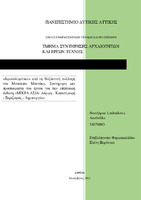| dc.contributor.advisor | Φαρμακαλίδου, Ελένη | |
| dc.contributor.author | Lushnikova, Anzhelika | |
| dc.date.accessioned | 2022-10-10T07:50:15Z | |
| dc.date.available | 2022-10-10T07:50:15Z | |
| dc.date.issued | 2022-09-30 | |
| dc.identifier.uri | https://polynoe.lib.uniwa.gr/xmlui/handle/11400/3027 | |
| dc.identifier.uri | http://dx.doi.org/10.26265/polynoe-2867 | |
| dc.description.abstract | Η παρούσα πτυχιακή εργασία αφορά την συντήρηση του ζωγραφικού έργου σε ύφασμα με θέμα «Ιεροσολυμίτικο» από τη Βυζαντινή συλλογή του Μουσείου Μπενάκη. Συντήρηση και προετοιμασία του έργου για την επετειακή έκθεση «ΜΙΚΡΑ ΑΣΙΑ: Λάμψη - Καταστροφή - Ξεριζωμός - Δημιουργία».
Τα Ιεροσολυμίτικα είναι θρησκευτικής αξίας έργα σε ύφασμα με αναμνηστικό χαρακτήρα από προσκύνημα στα Ιεροσόλυμα, η παραγωγή αυτών ανθίζει το 18ο αιώνα και εξασθενεί έως τον 20ο αιώνα, γεγονός που τα καθιστά δυσεύρετα. Η τεχνολογία κατασκευής των έργων αυτών και η μέθοδος αποθήκευσής τους οφείλονται συνδυαστικά για την εκτενή παθολογία που παρουσιάζουν.
Για τις ανάγκες της συντήρησης του έργου μελετήθηκαν και τεκμηριώθηκαν η παθολογία και η τεχνολογία του έργου με την φωτογραφική αποτύπωση στο Vis- UV. Η IR φωτογράφιση επέτρεψε την παραλαβή πληροφοριών σχετικά με την εσωτερική δομή του ζωγραφικού στρώματος. Η παρατήρηση των δειγμάτων στο οπτικό πολωτικό μικροσκόπιο επέτρεψε την αναγνώριση του υλικού του καμβά ως βαμβακερό, ενώ η HPLC ανάλυση επέτρεψε την αναγνώριση του συνδετικού υλικού του ζωγραφικού στρώματος και της προετοιμασίας ως κρόκο αυγού σε ανάμειξη με ζωική κόλλα. Η SEM-EDS ανάλυση επέτρεψε την αναγνώριση της χημικής σύστασης των χρωστικών, με την οποία αναγνωρίστηκαν οι χρωστικές όπως μαύρο των οστών, κίτρινο του ψευδαργύρου, κίτρινο του χρώμιο-βαρίου, κίτρινη σανδαράχη, κίτρινο του χρωμίου, ψημένη όμπρα, κόκκινο του μολύβδου ή μίνιο, emerald green, ουλτραμαρίν, λευκό του μολύβδου και λευκό του ψευδαργύρου. Η FTIR ανάλυση έδωσε πληροφορίες σχετικά με το βερνίκι σανδαράχης που χρησιμοποιήθηκε.
Η συντήρηση του έργου περιλάμβανε την στερέωση ζωγραφικού στρώματος, καθαρισμό, επιπεδοποίηση του υφασμάτινου φορέα, φοδράρισμα και αισθητική αποκατάσταση με στόχο τη σταθεροποίηση και ανάδειξη του έργου για την επετειακή έκθεση του Μουσείου Μπενάκη. | el |
| dc.format.extent | 152 | el |
| dc.language.iso | el | el |
| dc.publisher | Πανεπιστήμιο Δυτικής Αττικής | el |
| dc.rights | Αναφορά Δημιουργού - Μη Εμπορική Χρήση - Παρόμοια Διανομή 4.0 Διεθνές | * |
| dc.rights.uri | https://creativecommons.org/licenses/by-nc-sa/4.0/deed.el | * |
| dc.subject | Ιεροσολυμίτικο | el |
| dc.subject | Αυγοτέμπερα | el |
| dc.subject | Τεχνολογία κατασκευής | el |
| dc.subject | Συντήρηση | el |
| dc.subject | HPLC | el |
| dc.subject | XRF | el |
| dc.subject | SEM-EDS | el |
| dc.subject | ATR-FTIR | el |
| dc.subject | Έκθεση | el |
| dc.title | «Ιεροσολυμίτικο» από τη Βυζαντινή συλλογή του Μουσείου Μπενάκη. Συντήρηση και προετοιμασία του έργου για την επετειακή έκθεση «ΜΙΚΡΑ ΑΣΙΑ: Λάμψη - Καταστροφή - Ξεριζωμός - Δημιουργία» | el |
| dc.title.alternative | "Jerusalemite" from Byzantine collection of the Benaki Museum. Restoration and preparation of the artwork for the anniversary exhibition "ASIA MINOR: Shine - Destruction - Eradication - Creation". | el |
| dc.type | Πτυχιακή εργασία | el |
| dc.contributor.committee | Φαρμακαλίδου, Ελένη | |
| dc.contributor.committee | Αλεξοπούλου, Αθηνά | |
| dc.contributor.committee | Boyatzis, Stamatis | |
| dc.contributor.faculty | Σχολή Εφαρμοσμένων Τεχνών & Πολιτισμού | el |
| dc.contributor.department | Τμήμα Συντήρησης Αρχαιοτήτων και Έργων Τέχνης | el |
| dc.description.abstracttranslated | The present thesis deals with the restoration of the panel painting with the theme “"Jerusalemite" from Byzantine collection of the Benaki Museum. Restoration and preparation of the artwork for the anniversary exhibition "ASIA MINOR: Shine - Destruction - Eradication - Creation"”.
The Jerusalemites are religious paintings on canvas with a commemorative character from a pilgrimage to Jerusalem. Their production starts in the 18th century and lasts until 20th century, which makes them unexplored. Both, the construction technology, and the storage method are accountable for the extensive pathology they present. For the restoration needs was crucial to investigate the technology and evaluate the deterioration of the painting.
For the restoration needs it was necessary first to study the preservation condition and technology of the artwork. For the documentation of the painting no destructive methodology was used. Vis-UV-IR photography for recording the condition and the technological features of the painted layer. Microscopy was used for the identification of the canvas material as cotton, while HPLC provide information about gesso ground and paint medium which was on both layers egg yolk with animal glue. SEM-EDS analysis it was possible to recognize by the chemical composition the used pigments, bone black, zinc yellow, barium-chromate yellow, orpiment, chrome yellow, umber, red lead, emerald green, ultramarine, white lead and zinc white. By FTIR analysis the original varnish was identified as sandarac resin.
The conservation treatment of the easel painting was carry out by the stabilization of paint layer with consolidating treatment, chemical cleaning of the oxidized varnish, humidification and flattening of the canvas, lining and stretching the easel painting, colour retouching and varnishing the paint layer add the finishing touches to prepare the artwork for the anniversary exhibition of the Benaki Museum. | el |


